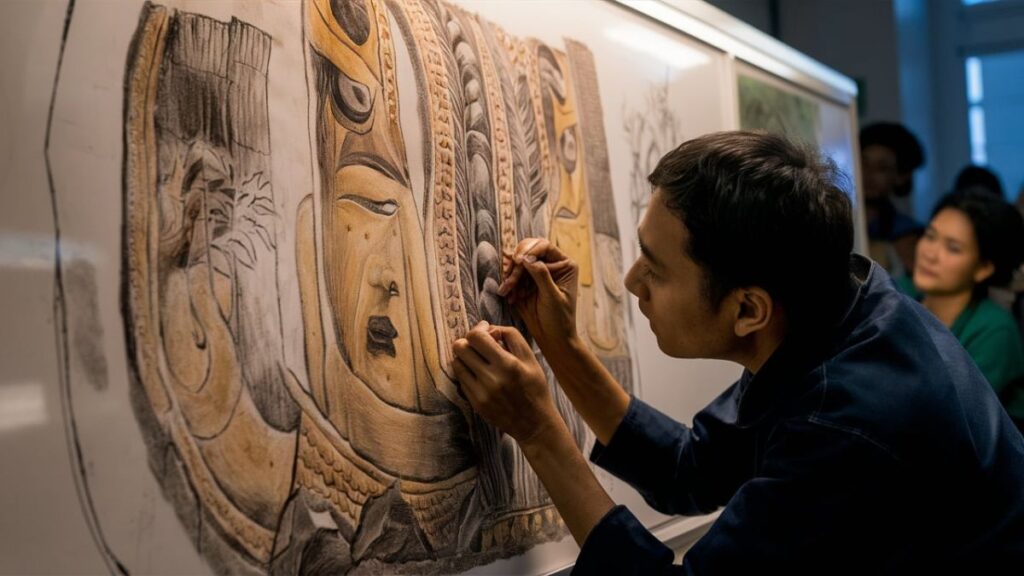Introduction
Art has always reflected human civilization, capturing beliefs, traditions, and emotions through various forms. When we talk about ancient art, we refer to art produced by ancient cultures worldwide, from intricate sculptures and pottery to wall paintings and jewelry. Understanding ancient art provides valuable insights into the roots of creativity and how it evolved over millennia. This blog post delves into ancient art’s origins, styles, and significance and why it continues to captivate modern audiences.
The Origins of Ancient Artz
Ancient art dates back thousands of years, emerging in regions such as Mesopotamia, Egypt, Greece, and China. Each culture brought its unique style, symbolism, and techniques to the art forms they created. Here’s a brief overview of some prominent ancient art movements:
Mesopotamian Artz
The Mesopotamian civilization, often called the “Cradle of Civilization,” laid the groundwork for ancient art. Artifacts from this region include sculptures, pottery, and elaborate ziggurats. Mesopotamian art was typically characterized by its intricate depictions of gods, humans, and mythical creatures, embodying themes of power, religion, and daily life.
Egyptian Artz
Egyptian ancient art is renowned for its precision, symbolism, and monumental structures, including the pyramids and temples. Art in ancient Egypt served religious and ceremonial purposes, often depicting gods, pharaohs, and scenes of the afterlife. The use of hieroglyphics and symbolic color schemes added layers of meaning to each piece, showcasing the Egyptians’ belief in the divine and the afterlife.
Greek Artz
Ancient art in Greece played a pivotal role in shaping Western aesthetics and ideals. Greek sculptures, such as those of deities and athletes, emphasized the human form’s perfection and balance. Classical Greek art introduced naturalism and movement, setting the stage for future artistic advancements.
Techniques and Mediums Used in Ancient Artz
The techniques and mediums employed in ancient art were as varied as the cultures that produced them. Here’s a look at some of the most notable techniques:
Stone Carving and Sculpture
Stone was one of the most popular materials for creating ancient art. Cultures like the Greeks, Egyptians, and Mayans used stone carving to produce statues and intricate reliefs. Stone’s durability allowed many pieces of ancient art to survive for thousands of years, offering modern historians a glimpse into the past.
Pottery and Ceramics
Ceramics and pottery are essential to ancient art, especially in ancient China and the Americas. These items were practical for daily use and served as canvases for artistic expression. Intricate patterns and depictions on pottery often told stories or conveyed religious symbolism.
Wall Paintings and Murals
The wall art was a vital form of ancient art, from the frescoes of ancient Rome to the rock paintings in Africa. These paintings often depicted religious rituals, hunting scenes, and social activities, preserving the essence of life in ancient times.
Metalwork and Jewelry
Cultures like the Egyptians and Incas excelled in metalwork, creating stunning jewelry and ceremonial objects. Using gold, silver, and precious stones was a hallmark of ancient art, highlighting wealth, status, and religious devotion.
The Symbolism in Ancient Artz
Symbolism was crucial in ancient art, embedding deeper meanings and narratives within each piece. For example, in ancient Egyptian art, specific colors like gold symbolized the eternal and divine, while blue represented fertility and protection. The Greeks used symbolic sculptures to honor gods and goddesses, showcasing the society’s reverence for their pantheon.
The Influence of Ancient Artz on Modern Culture
Understanding ancient art is essential for appreciating historical achievements and recognizing its profound influence on modern art and culture. Contemporary artists often draw inspiration from ancient techniques and themes through symbolism, naturalism, or storytelling.
Revival in Modern Art
Many contemporary artists and architects look back at ancient art for inspiration. For example, Brancusi’s minimalist sculptures echo Cycladic art’s simple yet powerful forms, while modern ceramicists often borrow techniques from ancient pottery.
Museums and Preservation
Ancient art is preserved and showcased in museums worldwide, such as the Louvre, the British Museum, and the Metropolitan Museum of Art. These institutions play a significant role in keeping ancient art alive and accessible, allowing people to appreciate its beauty and historical importance.
Famous Examples of Ancient Artz
Some ancient art pieces have become iconic, symbolizing their respective cultures and artistic achievements. Here are a few notable examples:
The Great Sphinx of Giza
One of the most recognizable symbols of ancient art, the Great Sphinx of Giza, is a testament to the Egyptians’ architectural prowess and religious beliefs. This colossal sculpture, with its lion’s body and human head, embodies strength and wisdom.
The Parthenon Sculptures
The Parthenon in Athens has some of the most stunning examples of ancient Greek art. These sculptures depict scenes from mythology and are celebrated for their exquisite detail and representation of movement.
Terracotta Army
In China, the Terracotta Army is a world-famous example of ancient art. This collection of life-sized clay soldiers was buried with Emperor Qin Shi Huang to accompany him in the afterlife, showcasing the Chinese commitment to elaborate funerary practices and the belief in life beyond death.
Why Ancient Artz Still Matters Today
The relevance of ancient art extends beyond history books; it resonates in today’s culture through architecture, design, and even fashion. People study ancient art to understand human nature, societal structures, and the evolution of creative expression better. By analyzing ancient works, we can trace the origins of ideas that have shaped artistic expression for centuries.
Conclusion
Ancient art holds an irreplaceable place in the story of human civilization. From the grandeur of the Egyptian pyramids to the refined sculptures of Greece, each piece of ancient art serves as a window into the past. Understanding these masterpieces enriches our knowledge of history and helps us appreciate the cultural roots that continue to influence modern art and daily life. By preserving and studying ancient art, we keep alive the spirit and creativity of those who came before us.
